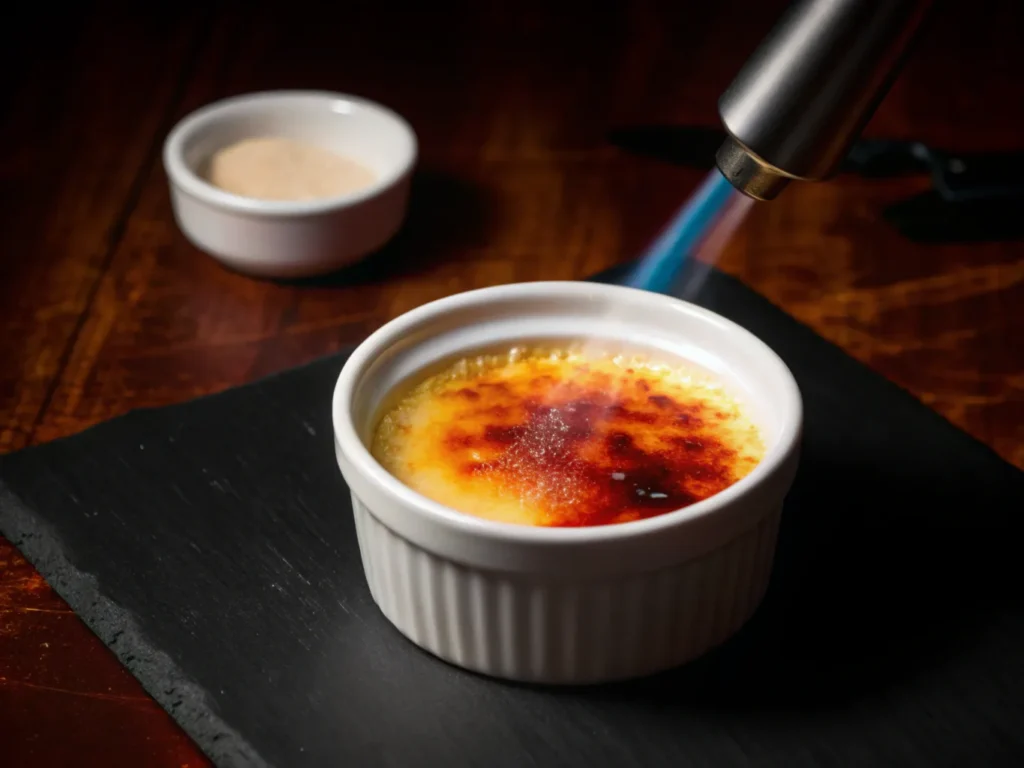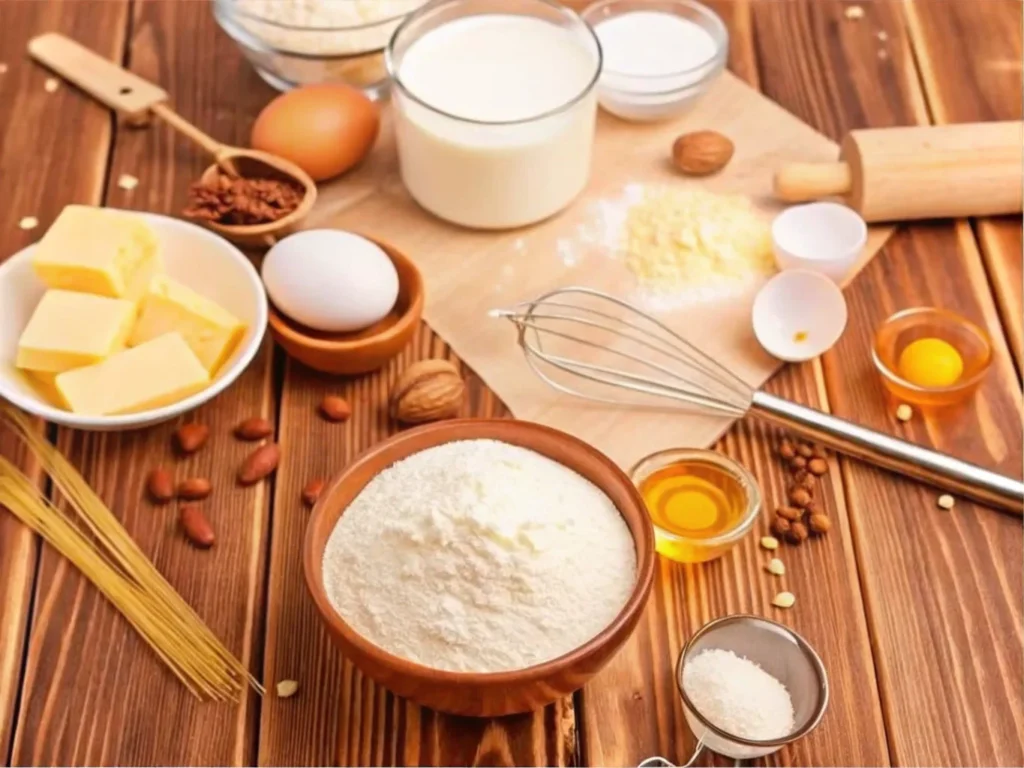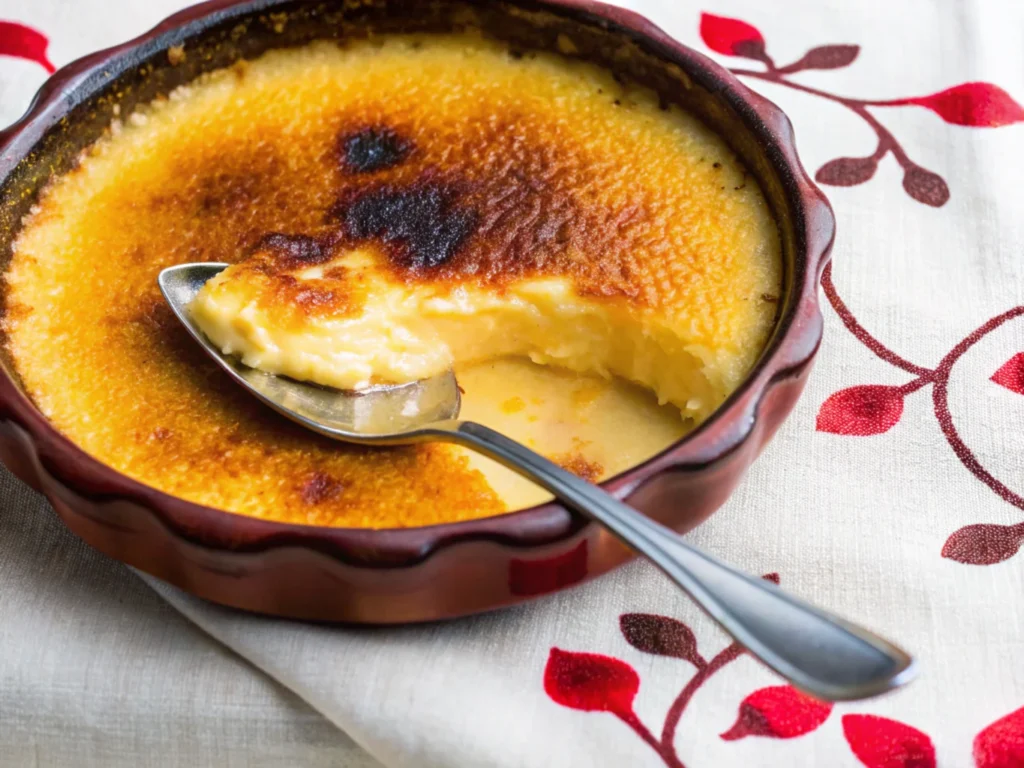Introduction
When it comes to indulgent desserts, crème brûlée and custard are two classics that often leave people scratching their heads. Are they the same? Or is one just a fancy version of the other? While both desserts share a common foundation—eggs, cream, sugar, and a touch of magic—their textures, flavors, and preparation methods set them apart. In this article, we’ll dive deep into the world of crème brûlée and custard, exploring their history, ingredients, textures, and even the techniques that make each dessert shine. So, if you’ve ever wondered, “What’s the difference between crème brûlée and custard?”, you’re in for a treat.
Table of contents
Overview of Crème Brûlée and Custard
What is Crème Brûlée?

Ah, crème brûlée! This elegant French dessert translates to “burnt cream,” a nod to its signature caramelized sugar crust. Beneath the crisp, glassy surface lies a silky, luxurious custard flavored with vanilla. It’s the ultimate combination of creamy and crunchy, making it a favorite in fine dining and home kitchens alike. First recorded in a French cookbook in 1691, this dessert has since traveled the globe, enchanting palates everywhere.
What makes crème brûlée truly unique is its dramatic finishing touch: a layer of sugar is torched or broiled to form a brittle caramel top. This delightful contrast of textures is one reason it’s so beloved.
What is Custard?
Custard, on the other hand, is more of a versatile foundation than a standalone dessert. At its core, custard is a mixture of milk or cream, eggs, sugar, and flavorings, gently cooked until it thickens. It comes in many forms: baked, stirred, or even frozen (think ice cream!).
Unlike crème brûlée, custard doesn’t always come with a caramelized top, but its smooth, creamy consistency is its hallmark. Whether it’s poured over fruit, used as a pie filling, or enjoyed on its own, custard is a dessert chameleon, adaptable to countless recipes and cultures.
The Shared Foundation
Both crème brûlée and custard share a common heritage: they’re egg-based desserts thickened by gentle heat. However, what sets them apart lies in their preparation, presentation, and that oh-so-important final flourish. As we continue, we’ll unravel the delicious nuances that make each dessert distinct.
Ingredients and Preparation
Key Ingredients in Crème Brûlée
| Ingredient | Quantity (Typical) | Purpose |
|---|
| Heavy Cream | 2 cups | Provides a rich, creamy texture |
| Egg Yolks | 4 large yolks | Adds structure and richness |
| Sugar | 1/2 cup (plus extra for topping) | Sweetens the dessert and caramelizes for the topping |
| Vanilla | 1 teaspoon or 1 vanilla bean | Infuses the custard with a delicate flavor |
For those looking to experiment, flavors like coffee, chocolate, or citrus zest can be added to give this dessert a unique twist. However, the basic ingredients remain simple, allowing the star of the show—the caramelized sugar topping—to shine.

Custard Ingredients Across Types
Custard ingredients vary depending on the type, but the base is nearly always the same: milk or cream, eggs, and sugar. Unlike crème brûlée, custard often uses milk or a milk-and-cream mix, resulting in a lighter texture. Some recipes even include starch, like cornstarch or flour, to help thicken the custard, especially in puddings and pie fillings.
While vanilla is a common flavoring, custards can take on bold profiles with chocolate, caramel, or fruit infusions. This adaptability makes custard a versatile dessert that can be enjoyed on its own or as part of a larger dish.
Preparation Methods
1. Crème Brûlée Preparation
- Preheat the oven and prepare a water bath for even baking.
- Mix heavy cream, egg yolks, sugar, and vanilla until smooth.
- Pour the mixture into ramekins.
- Place ramekins in a baking dish, then fill the dish with hot water halfway up the sides of the ramekins.
- Bake until the custard is just set.
- Cool, refrigerate, and caramelize the top with a blow torch or broiler before serving.
2. Custard Preparation
- Stirred Custard:
- Cook milk, eggs, and sugar on the stovetop, stirring continuously to avoid lumps.
- Thicken the mixture without letting it boil.
- Baked Custard:
- Pour the custard mixture into a dish or individual ramekins.
- Bake in a water bath for an even texture.
- Steamed Custard:
- Use a steamer or steam in small bowls for delicate, smooth results.
3. Key Differences in Methods
- Crème brûlée uses a water bath and is finished with caramelization.
- Custard preparation varies based on the desired form (stirred, baked, or steamed).
Texture and Flavor Profiles
Crème Brûlée’s Signature Features
Crème brûlée offers a sensory experience that’s hard to beat. The contrast between its crisp, caramelized sugar topping and the silky, custard-like base is its hallmark. With every spoonful, you get a satisfying crunch followed by a creamy, melt-in-your-mouth texture. It’s a dessert that engages both your taste buds and your ears—cracking that caramelized top is half the fun!
The flavor is equally indulgent. Thanks to the heavy cream and egg yolks, crème brûlée boasts a rich, buttery profile with subtle hints of vanilla. When variations like chocolate or espresso are added, the flavors become even more luxurious.

Custard’s Versatile Textures
Custard, by comparison, is a shape-shifter in the dessert world. Depending on how it’s prepared, it can be smooth and drinkable, like crème anglaise, or thick and sturdy, like pie filling. This adaptability is what makes custard so beloved across cultures and recipes.
Its flavor is typically lighter than that of crème brûlée, especially when made with milk instead of cream. Sweet, mild, and endlessly customizable, custard serves as the perfect canvas for other ingredients, such as fruits, spices, or caramel.
Comparing Flavor and Texture
Ultimately, the answer to “What’s the difference between crème brûlée and custard?” lies in these details. While both desserts are creamy and sweet, crème brûlée’s caramelized top and rich base make it more indulgent, whereas custard’s versatility and variety allow it to fit into countless culinary roles. Each has its unique charm, but both remain timeless favorites.
Historical and Cultural Context
The French Origins of Crème Brûlée
Crème brûlée’s roots trace back to 17th-century France, though similar desserts were also found in Spain and England. It gained its name, meaning “burnt cream,” due to its signature caramelized topping. Over time, this dessert became a staple in French cuisine, celebrated for its sophisticated texture and dramatic presentation. As French culinary traditions spread globally, crème brûlée became synonymous with elegance, making its way onto restaurant menus worldwide.
Custard Through the Ages
Custard boasts a much older and broader history. Ancient Romans used a mixture of milk and eggs to create dishes that resemble custard. By the Middle Ages, custard had become a popular filling for pies and tarts across Europe. Its versatility allowed for adaptations in every region, from flan in Spain to egg tarts in China.
Interestingly, custard’s adaptability is what sets it apart. Whether it’s baked, stirred, or steamed, custard has found a place in countless cultures and cuisines. It might not have the theatrical flair of crème brûlée, but its comforting simplicity is its greatest strength.
For more inspiration, check out the Crab Brûlée Recipe, a unique twist on classic brûlée techniques!
Popular Variations and Comparisons
Variations of Crème Brûlée
1. Classic Vanilla Crème Brûlée
- Features the traditional combination of heavy cream, egg yolks, sugar, and vanilla.
- Known for its rich, creamy base and crisp caramelized sugar top.
2. Flavored Crème Brûlée
- Chocolate Crème Brûlée: Incorporates melted chocolate into the custard for a decadent twist.
- Matcha Crème Brûlée: Uses matcha powder for a vibrant green hue and earthy flavor.
- Citrus Variations: Includes zest from oranges, lemons, or limes for a refreshing tang.
3. Liqueur-Infused Crème Brûlée
- Adds a splash of liqueurs like Grand Marnier, Amaretto, or Baileys to enhance the flavor profile.
4. Savory Crème Brûlée
- Substitutes sugar with savory ingredients like herbs, cheese, or seafood for a creative appetizer option.
- Example: Crab brûlée as a unique twist on the classic dessert.
5. Presentation Variations
- Experiment with shallow ramekins for more caramelized topping.
- Use different garnishes like fresh fruits, edible flowers, or flavored sugars.
Custard Comparisons
1. Classic Vanilla Crème Brûlée
- Features the traditional combination of heavy cream, egg yolks, sugar, and vanilla.
- Known for its rich, creamy base and crisp caramelized sugar top.
2. Flavored Crème Brûlée
- Chocolate Crème Brûlée: Incorporates melted chocolate into the custard for a decadent twist.
- Matcha Crème Brûlée: Uses matcha powder for a vibrant green hue and earthy flavor.
- Citrus Variations: Includes zest from oranges, lemons, or limes for a refreshing tang.
3. Liqueur-Infused Crème Brûlée
- Adds a splash of liqueurs like Grand Marnier, Amaretto, or Baileys to enhance the flavor profile.
4. Savory Crème Brûlée
- Substitutes sugar with savory ingredients like herbs, cheese, or seafood for a creative appetizer option.
- Example: Crab brûlée as a unique twist on the classic dessert.
5. Presentation Variations
- Experiment with shallow ramekins for more caramelized topping.
- Use different garnishes like fresh fruits, edible flowers, or flavored sugars.

Tips for Making Perfect Crème Brûlée and Custard at Home
Essential Tools and Techniques
To make flawless crème brûlée, you’ll need a blow torch to achieve that signature caramelized top. Baking in a water bath ensures even cooking, preventing the custard from curdling. For custard, precise temperature control is vital—overheating can result in a scrambled texture. Use a thermometer for perfect results.
Common Mistakes to Avoid
Don’t rush the process! High heat can ruin both desserts, leaving you with a grainy or curdled texture. For crème brûlée, make sure the sugar layer is thin for even caramelization. When preparing custard, stir constantly (if on the stovetop) to prevent lumps.
For more dessert tips, explore unique recipes like the Crab Brûlée Recipe for a creative spin on classic techniques.
By mastering these tips, you’ll elevate your culinary skills and answer what’s the difference between crème brûlée and custard in your own kitchen with confidence.
Nutritional Considerations
Caloric Content of Crème Brûlée
Crème brûlée is undeniably indulgent, thanks to its rich ingredients. The heavy cream and egg yolks contribute to its velvety texture but also pack in calories and fat. A typical serving contains about 250–350 calories, depending on the portion size and sugar content. For those keeping an eye on their diet, it’s best enjoyed as an occasional treat.
That said, this dessert also offers protein from the egg yolks and some calcium from the cream. If you’re wondering, “What’s the difference between crème brûlée and custard in terms of nutrition?” the answer lies in the cream. Crème brûlée is heavier due to its higher fat content.
Custard’s Nutritional Range
Custard tends to be lighter, especially when made with milk instead of cream. A single serving of milk-based custard can contain 150–200 calories, making it a more forgiving choice for calorie-conscious dessert lovers. Custards can also be made with alternative sweeteners and non-dairy milk to suit different dietary needs.
Both desserts are high in sugar, so moderation is key. Whether you opt for the luxurious crème brûlée or the versatile custard, enjoy every bite while being mindful of your overall nutritional goals.
FAQs
What is the secret of crème brûlée?
The secret to a perfect crème brûlée lies in balancing the creamy custard with a perfectly caramelized sugar crust. Key tips include:
Achieving the right sugar crust by evenly sprinkling sugar and torching it just enough to create a crispy, golden topping without burning.
Using high-quality ingredients like fresh cream and vanilla.
Baking the custard gently in a water bath to prevent curdling.
What are the 3 types of custard?
Custards can be categorized based on their preparation and texture:
Stirred Custard: Cooked on the stove and stirred to create a pourable consistency (e.g., crème anglaise).
Baked Custard: Set in the oven to achieve a firmer texture (e.g., crème brûlée, flan).
Set Custard: Uses gelatin or starch as a thickening agent for a firm and sliceable consistency (e.g., panna cotta).
What is the difference between baked custard and crème brûlée?
The main difference lies in the texture and finishing touches:
Baked Custard: Smooth and creamy, often served plain or with a sauce. It is not topped with anything crispy.
Crème Brûlée: Also a baked custard but has a signature caramelized sugar crust created by torching sugar on top, adding a contrasting crunch to the creamy custard.
Does crème brûlée taste like custard?
Yes, crème brûlée tastes like custard because it is essentially a rich, creamy custard base. However, it has a distinct caramelized sugar topping that adds a slightly burnt, nutty flavor and crunchy texture, setting it apart from traditional custard.
Conclusion
Crème brûlée and custard may share a foundation of simple ingredients, but they are unique desserts with distinct personalities. Crème brûlée dazzles with its crisp caramelized sugar topping and rich, velvety base, offering a touch of elegance in every bite. Custard, on the other hand, is a versatile classic, adaptable to countless dishes and flavor profiles, from silky crème caramel to creamy pie fillings.
So, what’s the difference between crème brûlée and custard? It’s all about texture, flavor, and presentation. Whether you prefer the theatrical crack of a brûlée or the comforting creaminess of custard, both desserts are timeless treats that promise to delight. Why not try making both at home and discover your personal favorite?

